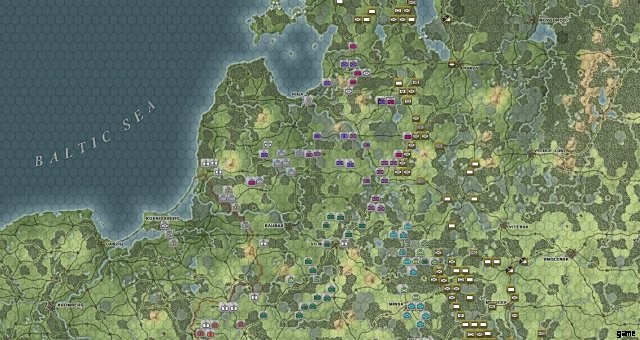
Ein kurzer Situationsbericht über meine Pläne für Runde 9, er sollte einem neuen Spieler Ideen geben, wie er seine Streitkräfte als Achsenspieler in War in the East einsetzen und positionieren kann.
Einführung
Dies ist ein kurzer Blick auf einen Abschnitt der Ostfront im Jahr 1941, der sich mit der 1. und 2. Panzergruppe (deutsch für Gruppen) – zwei Panzerarmeen – der deutschen Heeresgruppe Mitte (PzGr 2) unter von Bock und der Heeresgruppe Süd ( PzGr 1) unter von Rundstedt. Es begann eher als philosophischer Schnappschuss als als Leitfaden, während ich dann versuchte, die Logistik des Spiels so gut wie möglich zu erklären. Es wird dir immer noch nicht sagen, auf welche Schaltfläche du klicken sollst oder auf Mechaniken usw. ins Detail gehen, es ist eher eine Frage, wie du deine Kräfte einsetzen und einen bevorstehenden Zugführer planen kannst.
Ich habe das Spiel mit Axis-Mensch, sowjetischer KI, keinem sowjetischen Kampfbonus, reduziertem russischen Winter und erheblichen Boosts meiner Statistiken mit reduzierten sowjetischen Statistiken auf jeweils 95 eingerichtet. Immerhin ist es mein erstes Durchspielen!
Notizen
Begriffe und Abkürzungen:
MP / MPs:Bewegungspunkt oder -punkte
AB:Luftwaffenstützpunkt
KGr zbV:Kampfgruppe zur besonderen Verwendung – Battle Group Special Purposes or Operations. Deutsche Lufttransporteinheiten
FBD:Eisenbahnausbesserungswerk
Schienenkopf:Das nächstgelegene funktionierende (Schadensstufe null) Hex mit einer Eisenbahn darin, verbunden durch eine ununterbrochene und nicht blockierte Kette gleicher Hexen mit einer Versorgungsquelle.
Die Lage
In Runde 7 rückten die Sowjets mit einer großen Streitmacht an den Rand der Pripet-Sümpfe vor. Ich hatte die 2. Panzergruppe im Norden und die 1. Panzergruppe (im Folgenden abgekürzt PzGr) im Süden in Stellungen, die ich angesichts ihres damaligen Versorgungsstands und damit ihrer Bewegungspunkte für eine Einkreisung dieser Streitmacht nutzen zu können glaubte . Außerdem blockierten dünne sowjetische Streitkräfte den Weg dieser geplanten Einkreisung.
Der Konsens im viel gründlicheren Matrix-Forum / der Community ist, dass eine Strategie, die Rote Armee zu zerstören und so viele Bevölkerungszentren wie möglich zu nehmen, um der UdSSR Arbeitskräfte zu verweigern, eine solide Strategie für den Sieg der Achsenmächte ist. Ich verfolge diese Gesamtstrategie derzeit in meinem Spiel, daher stellte die Bewegung der sowjetischen Streitkräfte ein großartiges Ziel dar, um es in der klassischen deutschen Kesselschlacht oder „Kesselschlacht“ zu umkreisen und es mit Infanterie zu reduzieren, die sich aus dem Westen nähert.
Dies war nicht ohne Kompromisse.
Erstens wären die mobilen Streitkräfte der PzGr 1 und 2, die für den Erfolg von Barbarossa – im Wesentlichen die ersten 6 Kriegsmonate im Osten – unerlässlich sind, bestenfalls an der äußersten Grenze der Versorgung und im schlimmsten Fall jenseits des Nachschubs. Das würde die Hälfte der mobilen Streitkräfte der Achse in Runde 8 außer Gefecht setzen, was zusammen mit der 3. PzGr westlich von Moskau und der 4. PzGr, die größtenteils gegen die Außenverteidigung von Leningrad auf Infanterie wartet, bedeutete, dass ich es sein würde die letzten meiner mobilen Kräfte für mindestens eine Woche aufzugeben, vielleicht länger. Hat sich der Kompromiss gelohnt?
Zweitens hatte auch der Feind einen Zug und Aktionen, die er ausführen konnte …
Ich entschied, dass der beste Einsatz meiner Streitkräfte darin bestehen würde, die sowjetischen Formationen östlich der Pripet-Sümpfe einzukreisen. Ich führte die Einkreisung durch und verteilte meine Streitkräfte so weit wie möglich, versuchte aber, den Sowjets jede Möglichkeit zu verweigern, die Einkreisung zu durchbrechen.
Turn 8
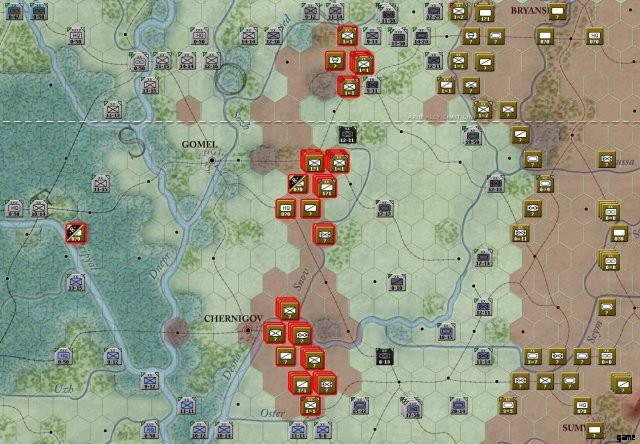
Die Situation östlich der Pripet-Sümpfe zu Beginn von Runde 8 nach der Luftaufklärung.
Die Einkreisung hielt, und meine Infanterietruppen konnten in Runde 8 vorrücken und den sowjetischen Kessel reduzieren. Ich kann nicht sagen, ob es sich gelohnt hat oder nicht, da das Spiel im Moment noch andauert. Ich habe jedoch eine große Reduzierung der sowjetischen Formationen (39 Divisionen und 9 Brigaden, Regimenter und kleinere Einheiten) und der Truppenstärke (386.914) erreicht. Von den Verlusten habe ich 329.030 Mann gefangen genommen, was für die Sache der Achsenmächte wichtig ist.
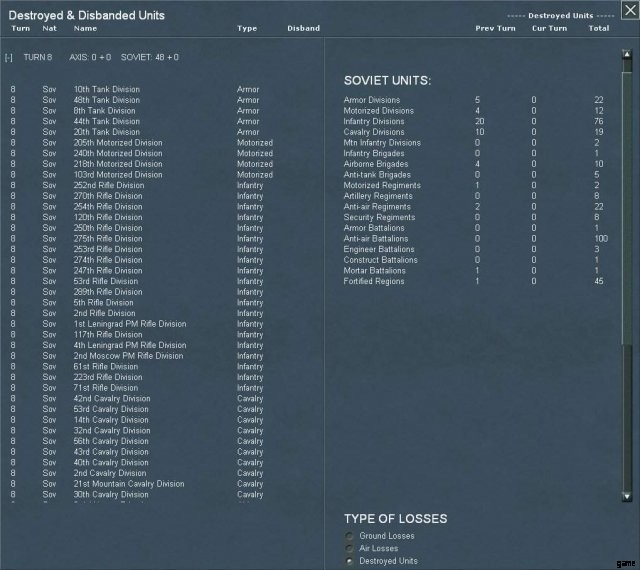
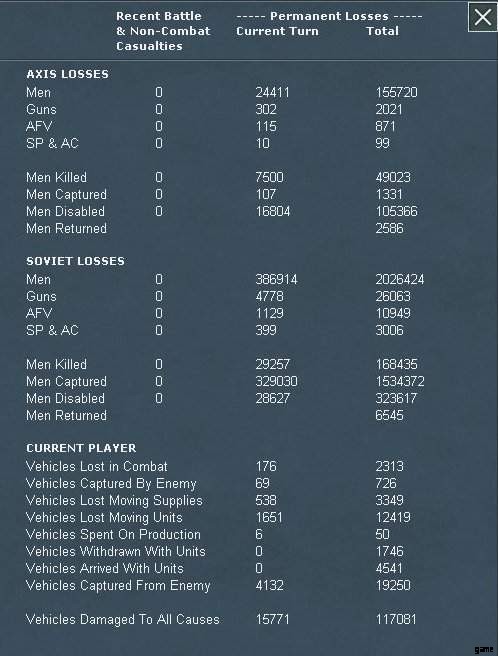
Gefangen genommene Arbeitskraft bietet den größten frühen Pool für Hiwi, Hilfswilliger, was „freiwillige Assistentin“ oder wörtlich „willige Helfer“ bedeutet (Wikipedia). Ich bin mir nicht sicher, was ihre Beschäftigung in WitE sein wird, aber in WitW, das ich viel öfter gespielt habe, werden Sie auf verschiedene Ost-Formationen stoßen, normalerweise Küstenverteidigungs- oder Sicherheitseinheiten von schlechter Qualität, die manchmal in den Kampf gedrängt wurden. Ich würde vermuten, dass, wie alle deutschen Bodenformationen, der Großteil im Osten eingesetzt worden wäre.
Ich habe Hinweise auf reguläre Wermachtseinheiten gesehen, bei denen deutsche Soldaten an der Seite von Elementen kämpften, die aus Hiwis bestanden, die anscheinend anders behandelt wurden als andere Freiwillige. Diese anderen Freiwilligen wurden in die SS aufgenommen, die Einheiten in Divisionsgröße aus fast allen von den Deutschen besetzten Ländern und einige Verbündete wie Ungarn umfasste.
Wie auch immer sie in WitE eingesetzt werden, mehr Arbeitskraft ist immer besser als weniger.
All das waren die guten Nachrichten in Kurve 8, zumindest in dem hier behandelten Abschnitt der Front. An anderer Stelle stießen die Achsenmächte vor, umkreisten Odessa, erreichten die Außenverteidigung von Leningrad und bewegten die Front fast über die gesamte Länge von der Ostsee bis zum Schwarzen Meer.
Allerdings erlebte ich meinen ersten Partisanenangriff westlich von Minsk. Das war ein unerwarteter sowjetischer Schachzug, auf den ich hätte verzichten können …
Kurve 9
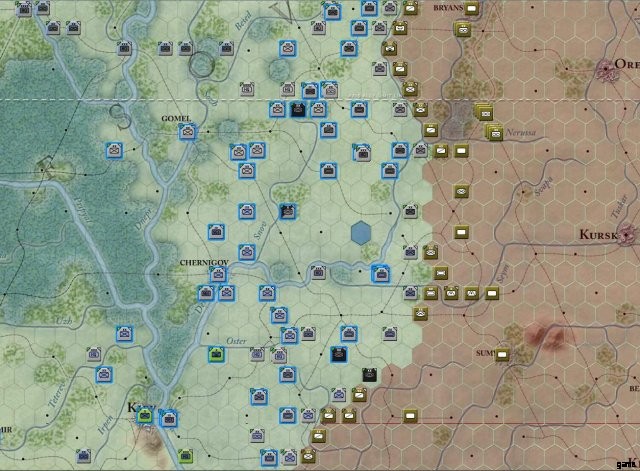
Erzwingen Sie Dispositionen östlich der Pripet-Sümpfe zu Beginn von Runde 9
In Runde neun verbesserte sich die Versorgungssituation sowohl für die 1. als auch für die 2. Panzergruppe, was durch die Umrüstung unterstützt wurde. Sie waren in Kurve 7 dünn gestreckt, um die sowjetischen Streitkräfte – fast 40 Divisionen – östlich der Pripet-Sümpfe einzukreisen. In Turn 8 wurden sie für die Versorgung mit HQ-Einheiten innerhalb von 25 Sechsecken um den Schienenkopf konsolidiert. Nicht gut. Armeehauptquartiere wurden ebenfalls an die Stelle verlegt, die sie in die bestmögliche Versorgungsposition brachte, während sie sich innerhalb von 5 Feldern von so vielen untergeordneten Kampfeinheiten innerhalb ihres Kommandos wie möglich befanden, um bei der Wiederherstellung zu helfen.
Die Katastrophe des Partisanenangriffs bei Minsk, der sich in Runde 8 (Hex 66,55) ereignete, hatte viele Folgen. Von Bocks nördliches FBD 2 sah ihre harte Arbeit etwa 10 Hexfelder weiter westlich zunichte machen, so dass PzGr 3 in und in der Nähe von Vyazma zusammen mit Elementen der 9. und 4. Armee verzweifelt unter Versorgungsmangel zurückblieb. FBD 2 verlagerte sich nach Süden, um mit den Arbeiten an einem Abzweig der Ostlinie von FBD 3 von Brest-Litowsk zu beginnen, verband sich bei Osipovichi (72,61) und fuhr nach Nordosten in Richtung Mogilev, während FBD 3 nach Osten weiterfuhr.
FBD-Positionen Heeresgruppenzentrum, Kurve 9. Rosafarbene Sechsecke sind beschädigte Schienen-Sechsecke, die von ausgewählten FBD erreicht werden können, obwohl nicht alle repariert werden konnten. Siehe Abschnitt 14.2 im Spielhandbuch für Details.
In der Zwischenzeit befanden sich IV/KG zbV 1, KGr zbV 105 und KGr zbV 9 weit entfernt vom Schienenkopf, jenseits der 5-Hex-Grenze, um Nachschubmissionen zu fliegen, da sie der nördlichen Eisenbahnlinie von FBD 2 gefolgt waren, die nach Osten vordrang. Dadurch wurden 3 der 5 Tante Ju-Gruppen entfernt, die dazu beigetragen hätten, entweder PzGr 3 in der Nähe von Vyazma oder PzGr 2 in ihrem Kordon in der Nähe des Pripet-Sumpfes zu versorgen. Zur South Luftflotte 4's KGr zbV 50 und 104 transportierten so viel Treibstoff wie möglich zu PzGr 1 und Elementen der 6. Armee, unterstützt durch einige Nachschublieferungen von IV und V Fliegerkorps He 111 und Ju 88.
FBD 1 gestapelt mit V FliegerKorps AB, Heeresgruppe Süd, Kurve 9. Auf dem Weg nach Osten werden die HQs für das ungarische (grün) und slowakische (hellbraun) Luftkontingent mit V FK HQ (gelb hervorgehoben) gestapelt; Östlich des HQ-Stapels auf einer Linie von 5 Sechsecken Entfernung befinden sich vordere Luftwaffenstützpunkte für V FK, die JG 3 (in Reihe mit HQs) und 2 Gruppen von StG 77 im Norden enthalten. Telemecus hat in den Matrix-Foren erklärt, dass vordere Luftwaffenstützpunkte die Reichweite Ihrer Bomber erweitern können, während sie sie in der vorteilhaftesten Versorgungsposition belassen. Beachten Sie AG South Auto Rail Repair in der Nähe von Proskurov. AB NE von Proskurov enthält die Ju 52 der Luftflotte 4 in KGr zbV 50 und KGr zbV 104
Damit blieben den mobilen Divisionen XIV und XXXXVIII der 1. Panzergruppe der Panzerkorps zwischen 23 und 28 MPs für die bevorstehende Aktion, und III Pz Korps, weiter südlich und näher an von Rundstedts FBD 1, mit 31-50.
PzGr 1 HQ ausgewählt, untergeordnetes Corps und Organic Recon AB hervorgehoben. Gestapelt mit dem Hauptquartier des LI Corps der 6. Armee, Turn 9
Im Norden hatte das XXXXVII Pz Korps von PzGr 2 – HQ 32 MP und 15 Felder von der Schiene entfernt in Runde 9 – seine drei mobilen Divisionen jeweils 40 MP. XXXXVI Pz Korps – 28 MP, 16 Felder – hatte 41/42/42 MP, mit der 1. Kavallerie (die in Runde 7 mehr als 5 MP vom Hauptquartier entfernt gestrandet war) bei 31 MP. XXIV Pz Korps bei 32 MP/20 Feldern hatte 29 MP für 10 Mot. Div., 28 für 4. Panzer und 33 für 3. Panzer. Die Infanteriedivisionen des Panzerkorps PzGr 2 hatten zwischen 11 und 15 MP.
Panzergruppe 2 ausgewählt mit hervorgehobenen untergeordneten Einheiten, Kurve 9. Luftwaffenstützpunkte südlich des Einsatzes sind die des VIII. Fliegerkorps, wobei die AB die drei Luftflotte 2 Ju 52 Gruppen etwas weiter westlich außerhalb des Bildbereichs enthält. Forward VIII FK Airbases enthalten die Bf 109 von JG 27, ein Geschwader von Ju 87 und die Bf 110 von SKG 210 auf den drei östlichsten Stützpunkten.
Diese Formationen werden von der 2. Armee im Norden und Teilen der 6. Armee im Süden unterstützt. Sie werden die Basis sein, gegen die die mobilen Streitkräfte – wenn alles nach Plan läuft – in Runde 10 den Feind quetschen werden. In Runde 8 haben sie die 20 Infanterie-, 10 Kavallerie-, 5 Panzer- und 4 motorisierten Divisionen sowie 4 Luftlandeeinheiten beseitigt Brigaden und ein einzelnes motorisiertes Regiment östlich des Pripet-Sumpfes eingeschlossen.
Aufstellung der 2. deutschen Armee, Beginn der 9. Runde
Während die 2. und 6. Armee den sowjetischen Kessel verkleinerten, errichteten ihre bolschewistischen Brüder weiter östlich eine hastige Verteidigungslinie. Ohne Treibstoff und Vorräte, ganz zu schweigen von einem starken Infanterieamboss, gegen den sie angreifen konnten, zogen sich die mobilen Streitkräfte größtenteils zurück, um sich neu zu formieren und sich für die kommende Runde auszuruhen.
FBD bezieht sich auf die vier Schienenreparatureinheiten, die den drei deutschen Heeresgruppenkommandos mit den Nummern 1 bis 4 zugeordnet sind.
Lieferung als Beilage oder Ihr neuer Logistikfreund!
Während Runde 8 wurden meine verschiedenen Hauptquartiere der Panzergruppe für die bestmögliche Versorgungsposition auf mindestens die 25-Hex-Distanz-zu-Schiene-Linie von Runde 8 zurückverlegt, ohne die Treibstofftanks der mobilen Streitkräfte weiter zu erschöpfen und zu leeren – Entfernungen, die im vorherigen Abschnitt angegeben wurden Der Abschnitt „Kurve 9“ befindet sich nach den Schienenverlängerungen über Flüsse und durch Wälder und Sümpfe in Kurve 8. Infanterie-Hauptquartiere wurden auch im Hinblick auf die Versorgungsreichweite positioniert.
Wenn ich in diesem Abschnitt Versorgung verwende, beziehe ich mich sowohl auf Brennstoff als auch auf Versorgung. While Fuel is seperately tracked and shipped to a unit, Supply delivered to a unit will further be divided into generic supply (food, water, fodder for horses, grease, tires etc.) and ammunition according to your first new friend you made when entering WitE, A Formula in a Rule!!
Please read through the following, even if your eyes begin to glaze over, there is a happy ending!
When you’re executing a pull-back to regroup and resupply, or positioning your headquarters units before ending your turn, some things to keep in mind are:
There are two measurements in hexes which are important to a given HQ’s draw of supply:range to nearest functioning (repaired) rail hex connected back to a side’s supply sources, and Movement Points (MPs) to that supplied, functioning rail hex. To view the status of your rail network, and supply sources (which will be highlighted in red – not shown in images), and the supply status of hexes under your control, use the rail overlay (hotkey ‘r’). These will be explained further in this section, but the game manual is the place to go for a real understanding of these rules.
Army Group South’s Northern sector, rail overlay on, turn 9. Green dots are connected, functioning rail hexes which supply can be drawn from (lower left). Red dots are hexes with 100% damaged rail lines, and useless for supply. Hex shading can also be seen, with the dark hexes (upper right) over 25 hexes range from a railhead.
The two measurements to a railhead can be thought of like this:range to railhead is what you can easily count on the map by counting hexes from the unit or HQ to functioning railhead. Movement Points to railhead are displayed when you hover the pointer over the hex you want to know the stats about, along with the range. The MP figure will account for terrain such as rivers and forests the supply line must cross to reach the drawing unit. In practice, while a unit is selected (you can’t select a unit while the rail overlay is on – to do so closes the rail overlay) I simply look at the info pop-up when I hover the mouse over a hex I want info on.
The XIV Panzer Korps has been selected in the stack (upper left, red NATO icon). Note the bottom two lines:Off Rail MP:32; Off Rail Range 26.
If the units highlighted in blue connected by blue lines to the HQ’s hex – XIV Pz’s combat units – advance more than 5 hexes into enemy territory, XIV Pz HQ will be forced to move to the hex line indicated by pointer and path of numbered dots (the numbers are the amount of MPs the HQ will have left when it arrives in that hex) or farther to remain in command contact with it’s units. It will, however, be beyond the 25 hex range from a supply source and will not receive supply during turn 10, nor will it’s units – unless a unit is within 25 hexes, in which case they will draw supply but at a disadvantage because their HQ is not in range to receive supply.
Again the XIV Pz Korps has been selected, but this time a path ostensibly closer to the rail lines is chosen. Notice that while the rail range is now 17, due to crossing a major river and entering a swamp the Off Rail MP remains 32 as in the previous example. Bear in mind that terrain effects the Off Rail MP number.
As range to railhead increases, supply received decreases, with a further decrease implemented past 10 hexes distance. This is in addition to movement point range, which also reduces supply received.
Use the rail overlay (hotkey ‘r’) to get a visual on where your supply limits are. Hexes over 10 hexes from a reailhead are shaded, hexes with a range of 26 or more to a railhead are darkly shaded and receive no supply but remain in supply for unit status purposes. A unit which is within 25 hexes but more than 100 MPs – or vice versa – remains in supply for status, but can not draw supply:a unit must be either within 100 MPs or 25 hexes range to railhead to avoid penalties for being out of supply, but within both to draw supply from the rail network.
Simply:getting no supply bad, status achievement ‘out of supply’ even worse!
Keep your units within the first shaded area and you should avoid major problems with supply. Your decision then is how far to push your forces, knowing that the further into the shaded areas, the worse the supply situation in your units will be going into the ensuing turn, and the shorter any of their movements are going to be (including ability to attack which requires MPs).
Push the limit and achieve a glorious victory or debilitating encirclement, or be cautious and remain well supplied and therefore more flexible? That’s your real choice in WitE, not ‘counting trucks’ or getting bogged down in the minutia of logistics. Those choices for the Axis player will, as was the case historically, become very important for the player around the time Army Group Center reaches Smolensk.*
While all this might seem complex to someone who’s not played the game, it’s not really as bad as it seems. It’s more important that you are familiar with these rules than it is that you can quote them from memory like a lawyer arguing a case before a judge.
Keep your units together. Not only is this necessary for the German doctrine of Schwerpunkt (an operational focus on getting the most forces they could to the decisive place on the battlefield they needed to be when they need to be there), it helps them recover supplies and readiness for future action.
It’s very important to remember the first and best supply source for your combat units – the ones that close with the enemy and impose your will upon them (or resist the enemy’s attempts to do same) – is the HQ they are attached to, which has a command range of 5 for supply purposes regardless of whether it’s a Corps, Army, or higher level HQ. Beyond 5 hexes distant from their HQ, units will try to draw supply from a railhead, but only on the second supply round – this gives the unit only one chance to draw supply and is far less efficient.
While a unit itself might be beyond the 25 hexes from a railhead which are in range to draw supply, if it’s HQ unit is inside that 25 hex range the unit will still draw much better supply than one who’s HQ is also beyond the 25 hex line – provided the unit remains within 5 hexes of their HQ as the crow flies. The Movement Point distance is also important, and must remain within 20 MPs from that unit’s HQ to draw supply.
The movement points from a railhead to an HQ are important to the supply the HQ can get to then pass along to it’s units or to stockpile. There’s a formula that reduces the amount of supply based on how many MPs are expended to get supply to the HQ, which in turn increases the number of trucks that are damaged and (fewer) destroyed in the movement of that supply.
Keep attached on-map units within 5 hexes of their HQ at all times unless there is a really very good reason not to! Not only will supply suffer, an HQ won’t be able to share support squad elements with an on-map unit which is more than 5 hexes from their HQ – support squads help in recovery of damaged equipment and recovery of your units’ stats.
While overall not as important as the HQ an on-map unit is attached to, a higher HQ (Army, Army Gruppe or Soviet equivalent) attached to the unit’s chain of command will also try to help with Support Squads during the appropriate section of the logistics phase.
Returning to this image of the 2. PzGr, it’s interesting to note that the units stacked with and closest to the PzGr HQ – XXXXVII Pz – got 40 MPs for each of it’s mobile units, while the XXXXVI Pz just to the South and one hex further in range yet 4 MPs closer to rail, got more than 40 MPs for every mobile unit save the 1. Cavalry, which is outside the 5 hex range of the 1. PzGr HQ but was also outside HQ supply range on turn 8. Furthest South is the XXIV Pz Korps, which is farthest ranged at 20 hexes, but the same 32 MPs from rail as the XXXXVII Pz., and has the least mobile unit movement points.
In the South, 2 out of 3 of 1.PzGr’s Korps ended turn 8 with their HQs at the 25 hex limit of supply, with a long MP haul from the rail as well. The exception, South-most III Pz Korps, ended up with the highest MPs of any of these formations for turn 9, and was the only 1. PzGr formation to have all it’s units within the 5 hex command range of their immediate higher HQ.
Support Squad help flows down the chain of command linearly, and is only shared between higher HQs and subordinates.
Note that ‘Support Squads’ referenced above are not support units such as artillery, pioneer, or StuG units. Support squads are listed in a unit’s TOE and are the organic non-combat elements of the larger formation. An HQ may share it’s Support Squads with it’s subordinates to help in recovery. This is doubly important for Air bases in WitE, so keep them as close to their command chain as possible.
Regarding Support Units, for them to be committed to a battle they must either be attached directly to the unit, or the HQ has to again be within 5 hexes of their combat unit or units involved in the battle. While I’ve glossed over the fact that closer is better for supply, it is very important for HQ commitment of Support Units. Note that Artillery units can not be directly attached to combat units.
To get you started and playing the game with enjoyment, this outline is really all you need to know about these topics, but of course there is much more to it, others more qualified than myself must take that form here.
The plan is to create as many encirclements as possible during turn 9 – as many as 3. Two big ones maybe, or perhaps only two small ones due to bad die rolls or other circumstances. Unlikely but maybe one big one to rule them all, or maybe just a small one because reasons. Point is, I tried to set up the combined Panzer Gruppe forces and infantry army backing to enable as good an encirclement of enemy forces as I can manage. Infantry form 6th and 2nd Army will punch holes where possible, then movement points will dictate what’s possible after that.
That is a strategy of destroying the Red Army and taking as many population centers as you can to deny manpower to the USSR is a sound strategy for Axis victory. We shall see to the best of my abilities. I’m optimistic about taking Leningrad, though the KV factory is gone as well as everything else the Reds can move. I would imagine that a push to Moscow might be feasible, though I read that taking and still holding Moscow after the Soviet Winter Offensive are two different things.
I should also mention that when I set up this game I set rather large benefits across the board for myself, especially in Administration because I want the extra APs. I find the APs – at least in WitW with all the command shake-ups prior to Overlord – are too few to do what was historically done. This being my first time through WitE, I wanted to give that boost ‘just in case.’ Otherwise I just don’t want to be shouting at my monitor in frustration at 2am and waking up the house, lol! For a newbie, I would definitely suggest boosting your stats to as much as 125 and reduce the Soviets a bit – I set them at 95 myself for, again, my first playthrough.
Also – historically the Axis did not win in Russia. From what I’ve read, it was probably impossible to have won, save for astute strategic reasoning and precise execution on the ground, which Hitler himself precluded with his decisions and decrees. Even with the large benefit I gave myself, I am still not sure of victory, given this is my first try. From what I’ve read on Matrix, it’s quite possible to win without an unbalanced setup and giving the Soviets an advantage (+1 defense or attack). I wanted to give myself a chance to win with all my known and unknown limitations going in.
I’m finding this game quite enjoyable, and beginning to worry that I might have set it up wrong(too easy), so I might change things going forward. I know I boosted things higher than I did when I played WitW, and in the West I didn’t cut the Axis stats at all. I believe all I did there was to boost the Administration stat to 105 or 110, and left the rest at 100.
The primary reason I played WitW first, with only enough WitE time to familiarize myself with the game’s legacy rules and system, is WitW is one of the very few detailed, interesting wargames which offers as interesting a play situation as the Germans typically start out with whether in 1936, 1939, 1940, or 1941. I can think of none other than War in the West.
I think this is the primary reason so many gamers play as the Germans generally across the greater WWII in Europe strategy video game spectrum. The Germans start out with a superior army, sometimes – like WitE – realistically reflected in terms of experience and organization more than (historically non-existent) hordes of armored and mechanized forces used by other games. I also enjoy a light game like Panzer Corps and own that complete set of extended German campaigns. I have also enjoyed the Making History series of games.
One thing I’ve seen is that the rules are daunting to some. I have been playing games similar to this in complexity since I was a kid, so for me it’s nice to find a computer game that ‘feels’ like an old paper game. It’s a challenge to get a grip on the rules, no doubt, but once you figure it out not only are WitE and WitW both great games that will provide hundreds of hours of entertainment (and historical education!) for you, you’ll also open the door to hundreds of games out there both computer and paper that will entertain, educate, and challenge you and your friends for years.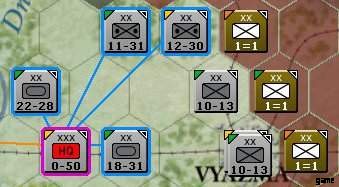
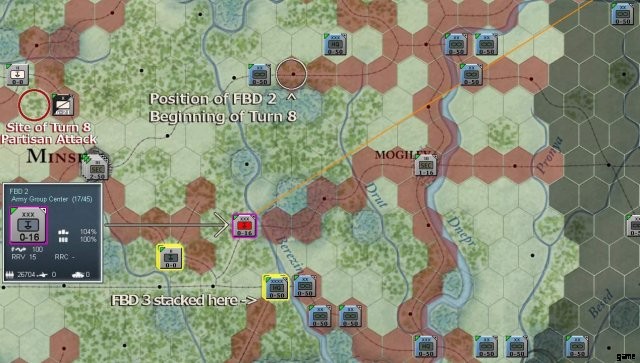
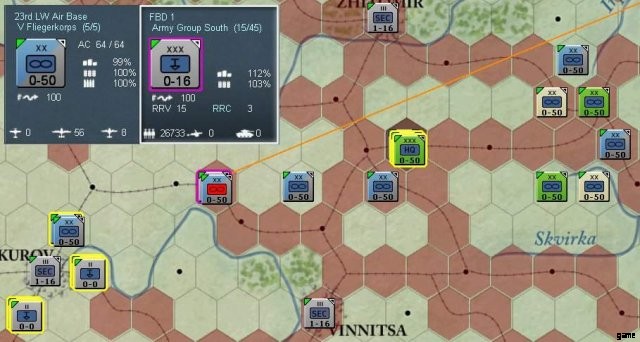
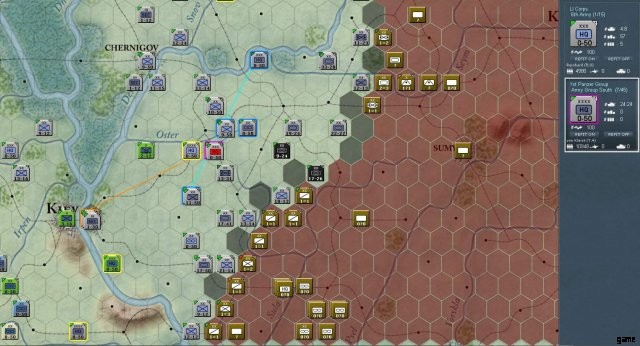
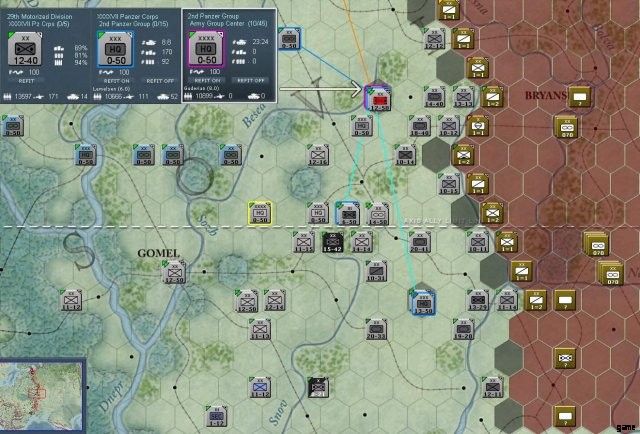
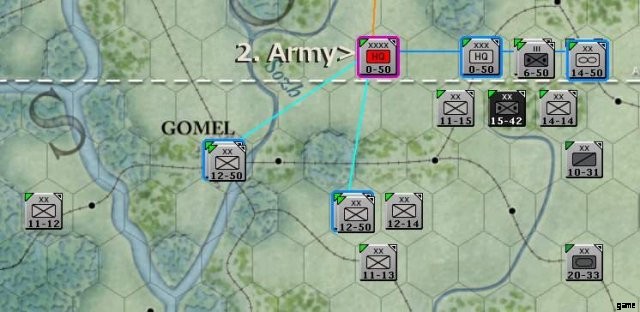
Notizen
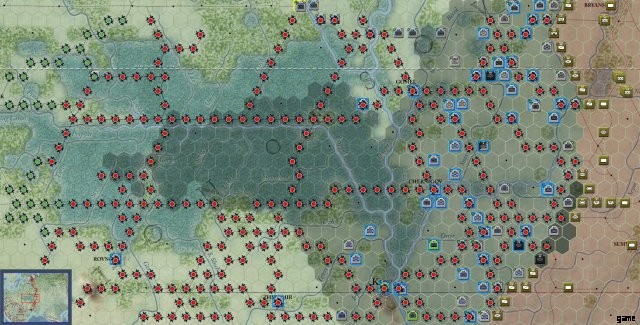

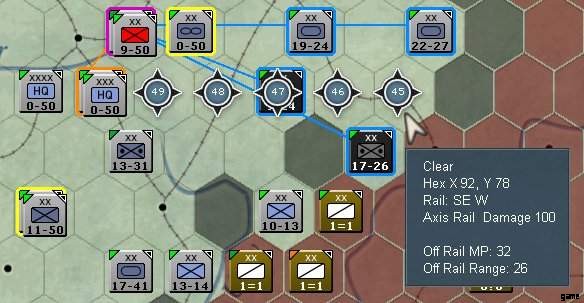
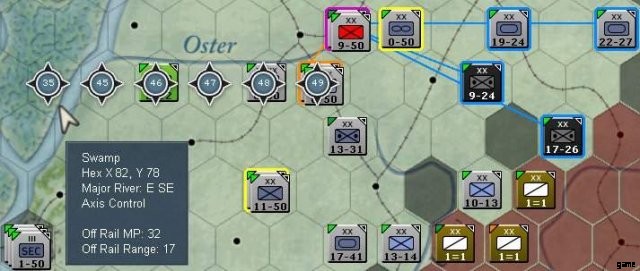
HQ Management / Support

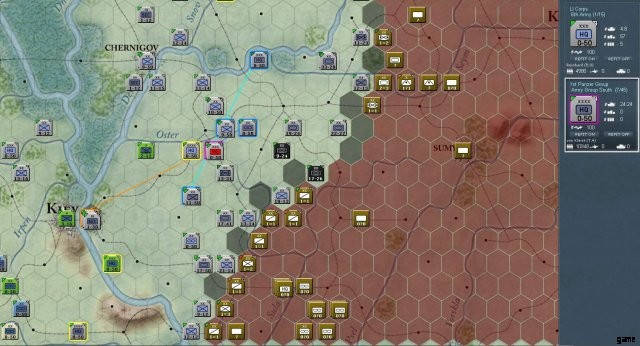
Example:6 Army HQ may attempt to send Support Squads to a division which is in range and attached to a Corps which is in turn attached to 6 Army, as may Army Group South if in range. However, a Corps attached to 11 Army will only get support to it’s units from the Corps HQ, 11 Army, and Army Group South if in range – even if stacked with 6 Army HQ or one of it’s subordinate Corps HQs. Similarly, Corps HQs attached to the same Army may only attempt to support on-map units which are subordinate to it.The Turn 9 Plan
Final Thoughts for Now
